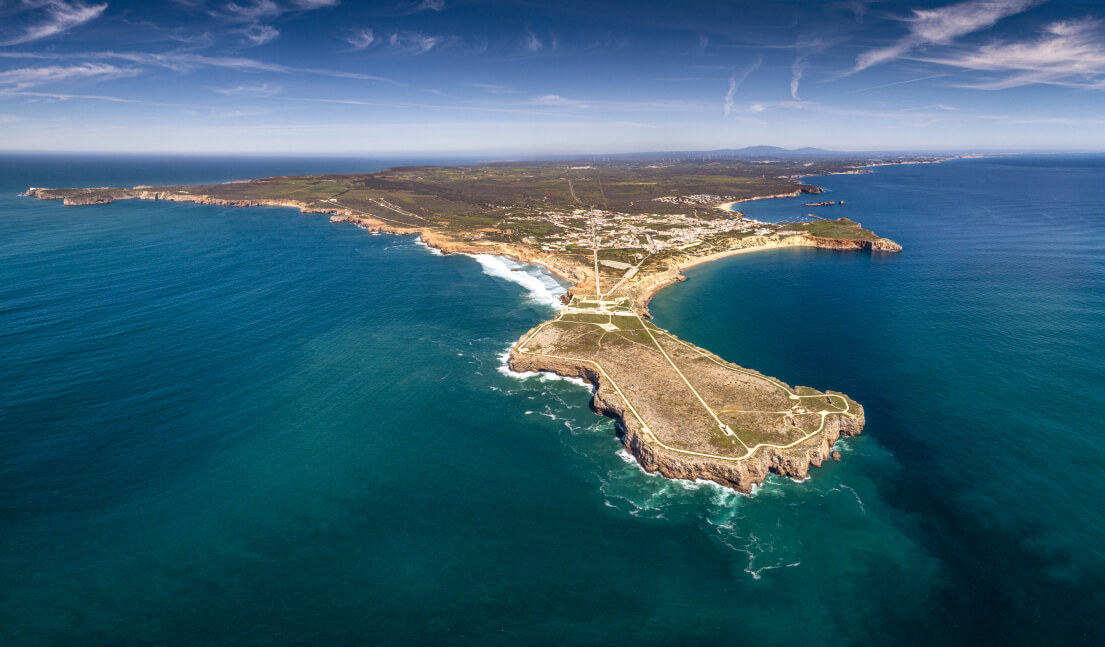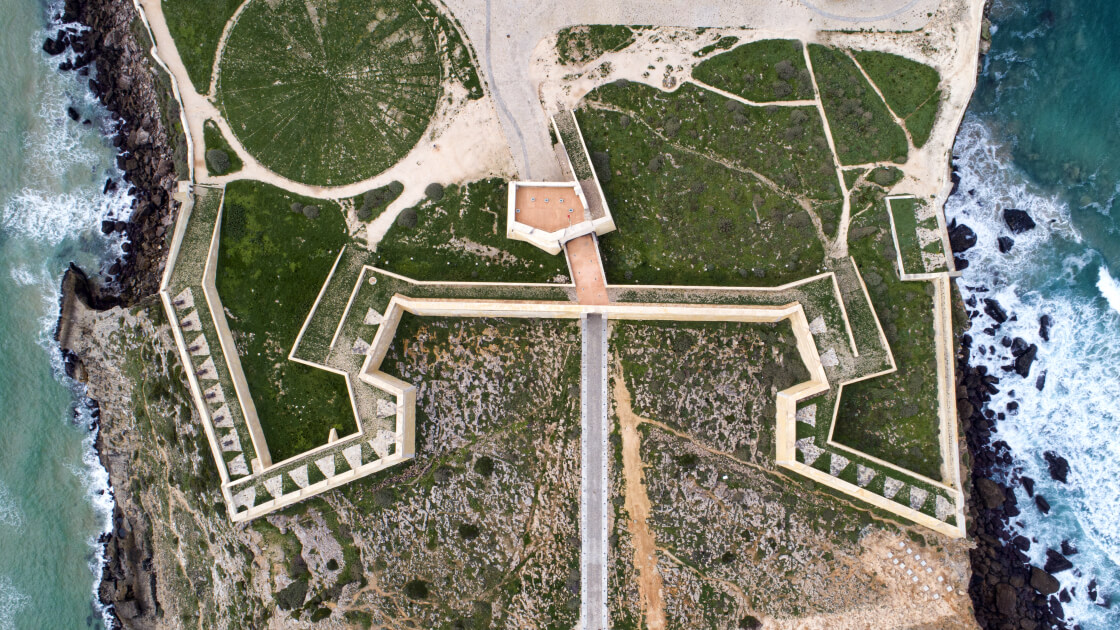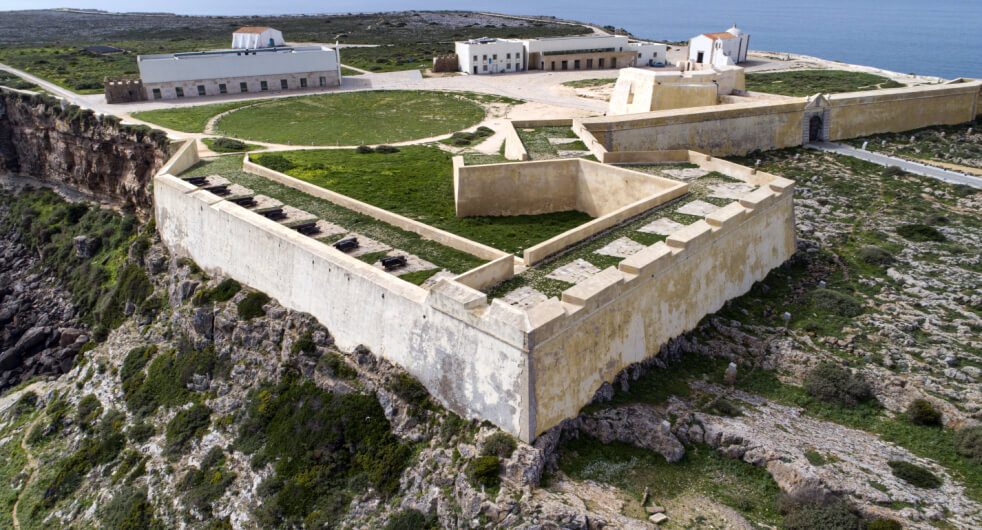This website uses cookies so that we can provide you with the best user experience possible. Cookie information is stored in your browser and performs functions such as recognising you when you return to our website and helping our team to understand which sections of the website you find most interesting and useful.
Sagres Promontory



The EHL Site
The Sagres Promontory is a historic site, home to a remarkable fortress and numerous other significant structures. Early traces of walls date back to the era of Henry the Navigator, featuring 16th-century bastions and an 18th-century tower. The “Correnteza” buildings originate from the 15th-century village, Vila do Infante, including a tower-tank and the “governor’s house”.
The N.ª Sr.ª da Graça Church, established by Infante D. Henrique in 1459 and remodelled in 1570, was the parish’s head until 1990. The complex also houses the enigmatic “Compass Rose” and an 18th-century fortress designed by José de Sande Lemos, featuring two bulwarks and a neoclassic gate leading to the keeper’s house.
Recent 20th-century interventions by “Estado Novo” resulted in landscape reorganization and the creation of cultural equipment to support visitors. The Republic Government promoted further valorization works between 1993 and 1997.
The cultural landscape of Sagres Promontory encompasses one of Europe’s largest concentrations of Megalithic-era menhirs. Notably, it was the most significant pilgrimage site for Christian Mozarabs between the 8th and 12th centuries.
The history of Sagres is intertwined with other cultural elements in the Algarve’s far west. These include the Chapel of Our Lady of Guadalupe, a symbol of the religious dimension of Maritime Discoveries, and the city of Lagos, headquarters of the commercial empire in the era of Henry the Navigator. Lagos was also the site of the first black slaves captured by Europeans in the 15th century.
Finally, the Sagres Promontory is linked to a network of fortresses including São Vicente, Beliche and Baleeira, and an impressive underwater cultural heritage. This rich history positions Sagres as a key location in European history, maritime-military control, and as a border between Western Christianity and the Muslim world.
European dimension
A place of myths and memories, Sagres has long since become a property of European culture and universal reference. The symbolic, historical and physical values of the Promontory give visibility to a place that celebrates and symbolizes integration, ideals and history of Europe.
The Sagres Promontory is associated with the beginning of European expansionist movement that occurred at the beginning of the 15th century, in the Algarve, in the sense of «a first pier» which is at the origin of the creation of the global world through the action of Europe in the following centuries.
The Sagres Promontory is one of the physical places that European and universal memory associate with the wonders of the Portuguese Maritime Discoveries and with the beginning of important historic changes, including the development of world trade, exchange of human values and technological development, including vast cultural areas of the world that began to communicate with each other and share ideas and products. It is the place of mythical exceptional testimony, the known “Sagres School of Prince Henry the Navigator”, invented outside the Portuguese ideological space, at the European level.
This symbol has imposed itself universally as the initial brand of the cultural tradition of European civilisation, in the context of the maritime expansion and the impact that created an irreversible universal change. The Promontory is beautiful and has exceptional natural phenomena. Interesting geological, biophysical and climatic characteristics can be found that may be associated with the development of terrestrial ecosystems (endogenous plants and migratory routes of birds) and specific communities of coastal shore species. It is a promontory associated with the Promunturium Sacrum described by the authors of Classic Greco-Roman Antiquity (such as Strabo, Artemidorus, Èforo, Avienus), a mythical place where Hercules was worshipped (greek designation of the Phoenician god Melqart) and that in Antiquity was considered to be the end of the known world.
The organization
Sagres Promontory/Sagres is an organic unit of the Regional Directorate of Culture of the Algarve, a peripheral service of the direct administration of the State which mission is to create conditions for access to cultural assets, monitor activities an supervision of artistic production structures financed by services and organizations in the field of culture, monitoring of actions related to the safeguarding, valorization and dissemination of immovable, movable and intangible cultural heritage, and support for museums.
The vision for Sagres Promontory reflects the uniqueness of this National Monument, which is due to its geographical importance and its historical context as part of the story of the Portuguese Discoveries.
The mission of Sagres Promontory is to provide its visitors with a unique experience, enabling them to view all the different aspects of the Monument within an educational framework of the history associated with Sagres Fortress. To fulfil this mission, Sagres Promontory, as a public service, ensures that activities and initiatives are implemented with focus on cultural, social, educational and pedagogical aspects and is managed in a way that concentrates on carrying out promotional and operational activities focusing on its sustainability.
In addition to monumental space that includes its historical and architectural dimension and the dimension of natural heritage the Sagres promontory/Sagres Fortress offers an Exhibition Center with a long-term exhibition and temporary exhibitions of contemporary art and others including catalogues, itineraries and guides, audio guides).
A Education Service provides school-oriented visits for all levels of education and educational workshops for children and young people.
A annual program of artistic expression, music, theatre, dance, cinema and conference events. It offers also multilingual signs and publications.
